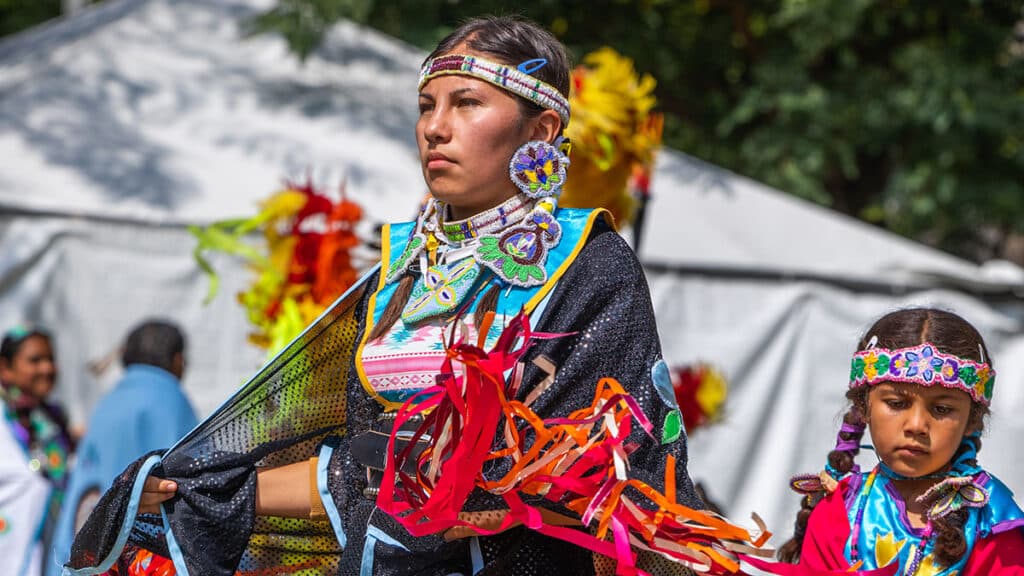
National Native American Heritage Month is a U.S. national celebration of the First Nations.
New York’s Native Americans are the Lenape. We are still here in New Jersey and Long Island. Many of us were forced to Oklahoma where Americans call us the Delaware because they met us on the Delaware River, which defines New Jersey’s western and southern borders.
National Native American Heritage Month
The national celebration was declared by President George H.W. Bush as National American Indian Heritage Month in 1990.
The celebration’s name has evolved since. The term “Indians” is a colonial mistake that has become embedded in many of the languages of the Americas. Indians live in India. The error makes things complicated for them too.
We use the term “Indigenous” because we represent Native Americans of all the Americas.
Native American Origins
Our understanding of Indigenous origins keeps evolving with new archeology and DNA studies. It is generally believed that Native Americans came from Northeast Asia, probably what is now Mongolia and Siberia around 13,000 years ago. But there are signals of earlier Indigenous peoples in South America, much earlier, and Australasian and Pacific Islander heritage.
Much is made of the Beringian land bridge between Asia and Alaska, but the ancients were great sailors and probably (like the colonizers) migrated by following the ocean currents.
The Pacific Islander connection is solid. We just don’t who visited who. Some Pacific Islanders have South American DNA from what is now Colombia. The South American sweet potato is a staple food in the Pacific. The prevailing idea is that Polynesians came to South America and returned with the sweet potato. They were and still are great oceanic sailors, but the South Pacific currents turn counter-clockwise. Ocean currents and winds are so strong, that once you enter the system, there is no coming out until you reach the other side. The same is true in the Atlantic.
There are traces of Australasian ancestry in some ancient South Americans. We don’t know what to make of it.
Once Native Americans arrived, they spread quickly throughout the Americas.
We Are Still Here
Americans of the United States have a strange relationship with Native Americans because our national narrative said the land was free for the taking, “Manifest Destiny” gave a god-given right to take the land, and the Indigenous genocide committed by the U.S. Army cleared the East of most Native Americans. Native Americans learned to keep quiet because complaining only brought violence.
“We are still here” has become a Native American and Indigenous lament of the United States and many other countries in the Americas. It’s a request for recognition and equal opportunity.
First of all, the Americas at the time of European contact were not empty land for the taking. The Americas were fully populated from the Arctic to Tierra del Fuego at the tip of South America. Trade networks ran the continents, and people managed the environment for their benefit. The people were not primitive. They were sophisticated societies. Some were hunter-gatherers, but most were farming cultures. Some built incredible civilizations that were the equal, and in some areas, more advanced than contemporary Europeans. Civilization, complex urban living, first appeared in Mexico around 1200 BC.
If you look at the gold work of ancient Colombians, the artistry, sophistication in the metallurgy (some of which we cannot replicate), and immense quantity of the gold suggest they were made by large, sophisticated societies. You can see some of that at the Metropolitan Museum of Modern Art.
European colonizers were lucky to find land that had already been cleared for farming by Native Americans. Over and over, Native Americans showed Europeans how to survive. The colonizers would have perished without that help.
One of the first things that happened at European contact in 1492 was pandemics. Europeans long lived in barns with farm animals below and the family above. They had developed immunity to contagious animal diseases like cowpox and smallpox. Indigenous Americans had no immunity and 85-95% died within a year or so of contact. Those who survived had to defend themselves against endless European violence and the taking of their lands.
Native Americans didn’t have guns or the European ever-war mentality. “Manifest Destiny,” the European Diaspora’s idea that they had a god-given right to take whatever they wanted, was the exact opposite of the teachings of the European god. The U.S. Army really did commit genocide against Native Americans. The Colonial Era was World War O, the European Diaspora against the whole world. Our history is often ugly, but the only way forward is to accept it and move on together. After endless killing of native women and children, Chief Joseph of the Nez Perce, the last free Native American tribe in the United States, said “I will fight no more forever” in 1877.
Still we didn’t die out. We married in and colonizers stopped counting us in their census. That trick is still used today as recently as the 2020 U.S. Census.
South of the U.S. border, the people and cultures are mostly Indigenous with Indigenous, African, and Asian influences. Mexico recognizes over 60 living Indigenous languages. In the Dominican Republic, some families still live in Indigenous Taíno ways. When their children tell their school teachers that the Indigenous tradition in the lesson is exactly how their families live today, their teachers tell them it can’t be true because you’re extinct. Ouch! In Puerto Rico, the Taíno tribe was absorbed, but some families still live in the old ways, and the general way Puerto Ricans and other Caribbeans live and socialize is a reflection of ancient Indigenous traditions.
It’s very strange that many Americans think Native Americans died out. We are still here.
